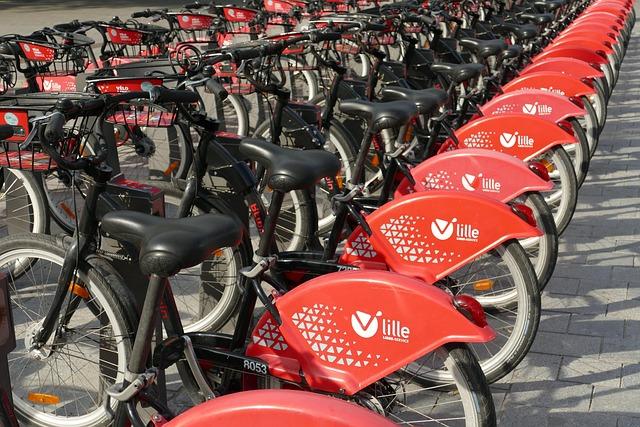Transforming Lille’s Public Transport Network: A Step Towards Sustainable Mobility
In an ambitious move towards a greener future, Lille is set to revamp its public transport network, supported by the European Climate, Infrastructure and Environment Executive Agency (CINEA). As cities globally grapple with the dual challenges of climate change and urban congestion, Lille’s initiative aims to not only enhance mobility for its residents but also significantly reduce carbon emissions. The plan encompasses a comprehensive overhaul of existing infrastructure, the integration of eco-friendly technology, and a commitment to improving accessibility across the metropolitan area. As European cities increasingly pivot towards sustainable urban development, Lille’s transformation is poised to serve as a model for others looking to make strides in environmental responsibility and public transportation efficiency.
Revolutionizing Urban Mobility in Lille through Sustainable Transport Solutions
Lille is taking significant strides towards enhancing its public transport network, aiming to reduce carbon emissions and promote sustainable mobility solutions. The European Climate, Infrastructure and Environment Executive Agency has partnered with local authorities to transform how residents and visitors navigate the city. Key initiatives include the expansion of electric bus routes, the integration of bicycle-sharing programs, and the development of pedestrian-friendly zones. By implementing these changes, Lille seeks to create a seamless transportation experience that prioritizes environmental health without sacrificing accessibility.
Central to this project is the incorporation of smart technology, which enhances not only the efficiency of public transport but also the overall user experience. Real-time tracking systems and mobile applications will enable passengers to plan their journeys better, contributing to improved customer satisfaction. Furthermore, community engagement workshops have been organized to gather feedback from citizens, ensuring that the measures adopted cater to the diverse needs of the population. As Lille revolutionizes its transport network, it sets a precedent for other cities in Europe looking to balance urban growth with ecological responsibility.
Enhancing Accessibility and Efficiency: The Future of Public Transport in Lille
The future of Lille’s public transport system is poised for a significant transformation aimed at boosting both accessibility and efficiency. With a renewed focus on sustainable solutions, Lille is implementing smart technology throughout its network. Key initiatives include the integration of real-time tracking systems, which will provide commuters with up-to-date information on transport schedules and routes. This technological upgrade will not only enhance user experience but also optimize operational efficiency by improving service frequency and reliability.
Furthermore, Lille aims to expand its infrastructure with a dedicated emphasis on green transport options. Plans to introduce electric buses and cycling lanes will promote eco-friendly commuting alternatives. The city’s commitment to inclusivity is reflected in its ongoing projects, including the installation of barrier-free access at all major stations and stops. These upgrades are expected to greatly benefit diverse populations, ensuring that public transport remains a viable option for everyone. Below is a summary of key initiatives designed to enhance public transport in Lille:
| Initiative | Description |
|---|---|
| Smart Technology | Real-time tracking for accurate scheduling and route management. |
| Electric Buses | Introduction of eco-friendly public transport vehicles. |
| Accessibility Enhancements | Barrier-free access to all major stations and stops. |
| Cycling Infrastructure | Development of dedicated cycling lanes to encourage bike use. |
Integrating Green Technologies into Lille’s Transport Infrastructure
Lille is on the brink of a transport revolution, as city planners and environmental experts collaborate to integrate cutting-edge green technologies into the public transport network. Aimed at significantly reducing carbon emissions, this ambitious plan involves the adoption of electric buses, renewable energy sources, and smart traffic management systems. These initiatives are expected to enhance both the efficiency and sustainability of the transport infrastructure, setting a precedent for other cities in Europe to follow. Key components of this transformation include:
- Deployment of Electric Buses: Transitioning from fossil fuel-dependent vehicles to a fleet of 100% electric buses.
- Solar-Powered Tram Stations: Implementation of solar panels to power tram stations, reducing energy costs.
- Smart Traffic Signals: Real-time data collection to optimize traffic flow and reduce emissions.
To support this transition, the city is also enhancing its cycling infrastructure and promoting the use of electric bicycles. A new network of dedicated bike lanes will connect key transport hubs, making cycling a viable option for commuters. Additionally, partnerships with local startups are fostering innovation in sustainable transport solutions, incorporating mobile apps that inform users about public transport options in real time. A comprehensive overview of planned green initiatives is summarized in the table below:
| Initiative | Objective | Expected Impact |
|---|---|---|
| Electric Buses | Reduce emissions from public transport | Lower urban pollution levels |
| Solar Tram Stations | Utilize renewable energy | Energy cost savings |
| Cycling Infrastructure | Encourage eco-friendly commuting | Decreased traffic congestion |
Community Engagement: Driving Public Support for Transport Innovations in Lille
In Lille, innovative transport solutions are gaining momentum, fueled by robust community engagement that fosters public support and drives meaningful change. Local residents are not just spectators but active participants in shaping the future of the city’s transport network. Through a series of interactive workshops, public forums, and surveys, community members have provided invaluable insights into their travel needs and aspirations. This participatory approach has led to the identification of key areas for improvement, ensuring that proposed initiatives align with citizen expectations and desires. Some highlighted concerns include:
- Accessibility: Ensuring that public transport is usable for all demographics.
- Eco-friendliness: Promoting sustainable transport options that reduce carbon footprints.
- Modernization: Integrating technology for improved user experience.
The city has taken these insights to heart, forming collaborative partnerships with local organizations and transport authorities. The result is a cohesive strategy aimed at not only modernizing Lille’s public transport but also embedding it into the community’s fabric. Recent initiatives include the launch of electric bus lines and the expansion of bike-sharing schemes, both designed to promote greener commuting options. A recent survey showed that 75% of respondents are excited about the switch to sustainable travel modes, demonstrating a palpable shift in public sentiment. Below is a table showcasing anticipated benefits from these innovations:
| Initiative | Expected Benefit |
|---|---|
| Electric Buses | Reduced emissions and noise pollution |
| Bike-Sharing Programs | Increased health and mobility |
| Smart Ticketing Systems | Simplified user experience |
To Conclude
As Lille embarks on a transformative journey to revamp its public transport network, the implications extend far beyond mere logistics. This initiative, supported by the European Climate, Infrastructure and Environment Executive Agency, not only aims to enhance mobility but also prioritizes sustainability in the face of a climate crisis. With investments in greener technologies and an emphasis on community engagement, Lille sets a precedent for other urban areas grappling with similar challenges. As the city’s residents prepare for a more efficient and environmentally conscious transport system, the success of this project could serve as a blueprint for cities across Europe striving towards a sustainable future. As we look ahead, the eyes of the continent will undoubtedly be on Lille, observing how these changes unfold and contribute to the broader goals of climate action and urban resilience.




